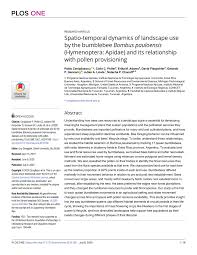Ver ítem
- xmlui.general.dspace_homeCentros Regionales y EEAsCentro Regional Entre RíosEEA ConcordiaArtículos científicosxmlui.ArtifactBrowser.ItemViewer.trail
- Inicio
- Centros Regionales y EEAs
- Centro Regional Entre Ríos
- EEA Concordia
- Artículos científicos
- Ver ítem
Spatio-temporal dynamics of landscape use by the bumblebee Bombus pauloensis (Hymenoptera: Apidae) and its relationship with pollen provisioning
Resumen
Understanding how bees use resources at a landscape scale is essential for developing meaningful management plans that sustain populations and the pollination services they provide. Bumblebees are important pollinators for many wild and cultivated plants, and have experienced steep population declines worldwide. Bee foraging behavior can be influenced by resource availability and bees’ lifecycle stage. To better understand these relationships, we studied
[ver mas...]
Understanding how bees use resources at a landscape scale is essential for developing meaningful management plans that sustain populations and the pollination services they provide. Bumblebees are important pollinators for many wild and cultivated plants, and have experienced steep population declines worldwide. Bee foraging behavior can be influenced by resource availability and bees’ lifecycle stage. To better understand these relationships, we studied the habitat selection of Bombus pauloensis by tracking 17 queen bumblebees with radio telemetry in blueberry fields in Entre Ríos province, Argentina. To evaluate land use and floral resources used by bumblebees, we tracked bees before and after nest establishment and estimated home ranges using minimum convex polygons and kernel density methods. We also classified the pollen on their bodies to identify the floral resources they used from the floral species available at that time. We characterized land use for each bee as the relative proportion of GPS points inside of each land use. Bumblebees differed markedly in their movement behavior in relation to pre and post nest establishment. Bees moved over larger areas, and mostly within blueberry fields, before nest establishment. In contrast, after establishing the nest, the bees preferred the edges near forest plantations and they changed the nutritional resources to prefer wild floral species. Our study is the first to track queen bumblebee movements in an agricultural setting and relate movement changes across time and space with pollen resource availability. This study provides insight into the way bumblebee queens use different habitat elements at crucial periods in their lifecycle, showing the importance of mass flowering crops like blueberry in the first stages of queen’s lifecycle, and how diversified landscapes help support bee populations as their needs changes during different phases of their lifecycle.
[Cerrar]

Autor
Cavigliasso, Pablo;
Phifer, Colin C.;
Adams, Erika M.;
Flaspohler, David J.;
Gennari, Gerardo Pablo;
Licata, Julián Andrés;
Chacoff, Natacha Paola;
Fuente
PLoS ONE 15 (7) : e0216190 (July 2020)
Fecha
2020-07
Editorial
Plos One
ISSN
1932-6203
Formato
pdf
Tipo de documento
artículo
Palabras Claves
Derechos de acceso
Abierto
 Excepto donde se diga explicitamente, este item se publica bajo la siguiente descripción: Creative Commons Attribution-NonCommercial-ShareAlike 2.5 Unported (CC BY-NC-SA 2.5)
Excepto donde se diga explicitamente, este item se publica bajo la siguiente descripción: Creative Commons Attribution-NonCommercial-ShareAlike 2.5 Unported (CC BY-NC-SA 2.5)


